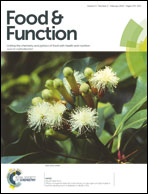Dietary gallic acid and anthocyanin cytotoxicity on human fibrosarcoma HT1080 cells. A study on the mode of action†
Abstract
Gallic acid and anthocyanins are abundant plant food bioactives present in many fruits and vegetables, being especially important in the composition of berries. Gallic acid has been shown to possess cytotoxic properties in several cancer cell lines and to inhibit carcinogenesis in animal models. However, its mechanism of action is not yet fully understood. The aim of this study was to elucidate whether the observed inhibitory activity of gallic acid against gelatinases corresponds to its cytotoxic activity in HT1080 cells and to determine if anthocyanins could exhibit a similar behavior. Gallic acid and delphinidin-3-glucoside have shown selective cytotoxicity towards HT1080 cells. Further analysis by a migration and invasion assay showed anti-invasive activities of gallic acid, delphinidin and pelargonidin-3-glucosides. Zymographic analysis demonstrated the inhibitory activity of gallic acid at the level of secreted and activated gelatinases. Moreover, gallic acid inhibited MMP-2 and MMP-9 proteolytic activity with very similar potency. NMR and molecular modelling experiments confirmed the interaction of gallic acid with MMP-2, and suggested that it takes place within the catalytic center. In this work we give some new experimental data supporting the role of these compounds in the inhibition of metalloproteases as the mechanism for their cytotoxic activity against fibrosarcoma.


 Please wait while we load your content...
Please wait while we load your content...